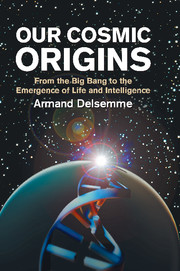Book contents
- Frontmatter
- Contents
- Foreword
- Preface
- Acknowledgments
- 1 Locating humans in the Universe
- 2 The race toward complexity
- 3 The stellar alchemy of metals
- 4 The formation of the planets
- 5 The emergence of life
- 6 The history of life
- 7 The awakening of intelligence
- 8 The other worlds
- 9 Perspectives
- APPENDIX A The standard model of the physics of elementary particles
- APPENDIX B Symmetry in physics
- APPENDIX C The strange role of time in relativity
- APPENDIX D The measurement of long time spans and the age of the Universe
- APPENDIX E The standard model of the Big Bang
- APPENDIX F The cause of the Big Bang and inflation
- APPENDIX G Chirality
- Glossary
- Bibliography
- Figure index
- Table index
- Name index
- Subject index
2 - The race toward complexity
Published online by Cambridge University Press: 05 August 2012
- Frontmatter
- Contents
- Foreword
- Preface
- Acknowledgments
- 1 Locating humans in the Universe
- 2 The race toward complexity
- 3 The stellar alchemy of metals
- 4 The formation of the planets
- 5 The emergence of life
- 6 The history of life
- 7 The awakening of intelligence
- 8 The other worlds
- 9 Perspectives
- APPENDIX A The standard model of the physics of elementary particles
- APPENDIX B Symmetry in physics
- APPENDIX C The strange role of time in relativity
- APPENDIX D The measurement of long time spans and the age of the Universe
- APPENDIX E The standard model of the Big Bang
- APPENDIX F The cause of the Big Bang and inflation
- APPENDIX G Chirality
- Glossary
- Bibliography
- Figure index
- Table index
- Name index
- Subject index
Summary
I would like to know how God created the world. I am not interested in this or that phenomenon, in the spectrum of this or that element. I would like to know His thoughts, the rest is detail.
Einstein (quoted by Freeman Dyson, 1988)Man must cling to the belief that the incomprehensible is comprehensible. Otherwise he would give up investigating.
Goethe, Maxims and Reflections, 1829The grand beginning
Let us summarize the initial events in their chronological order. First, we can imagine a quantum fluctuation in the void, which began everything. The perfect symmetry of the little bubble of pure energy is unstable and breaks up spontaneously. We follow it at the instant when it is still smaller than a proton. It inflates exponentially while creating its space–time dimensions and, after 10-32 second, it is already larger than the present Solar System. This exponential ‘inflation’ (see Appendix F) creates all the matter and all the radiation still present in the Universe.
After that, the phase transition ends. The change of state has forever broken the initial symmetry. From now on, only the nuclear forces will remain confined between the quarks, whereas the forces of gravity and electromagnetism now act at a distance. The Universe will continue its expansion in an almost linear manner, restrained merely by gravitation, right up to the present.
But where did all this energy come from, with its ability to create the enormous bulk of matter and radiation that we see in the stars and the galaxies?
- Type
- Chapter
- Information
- Our Cosmic OriginsFrom the Big Bang to the Emergence of Life and Intelligence, pp. 19 - 42Publisher: Cambridge University PressPrint publication year: 1998



